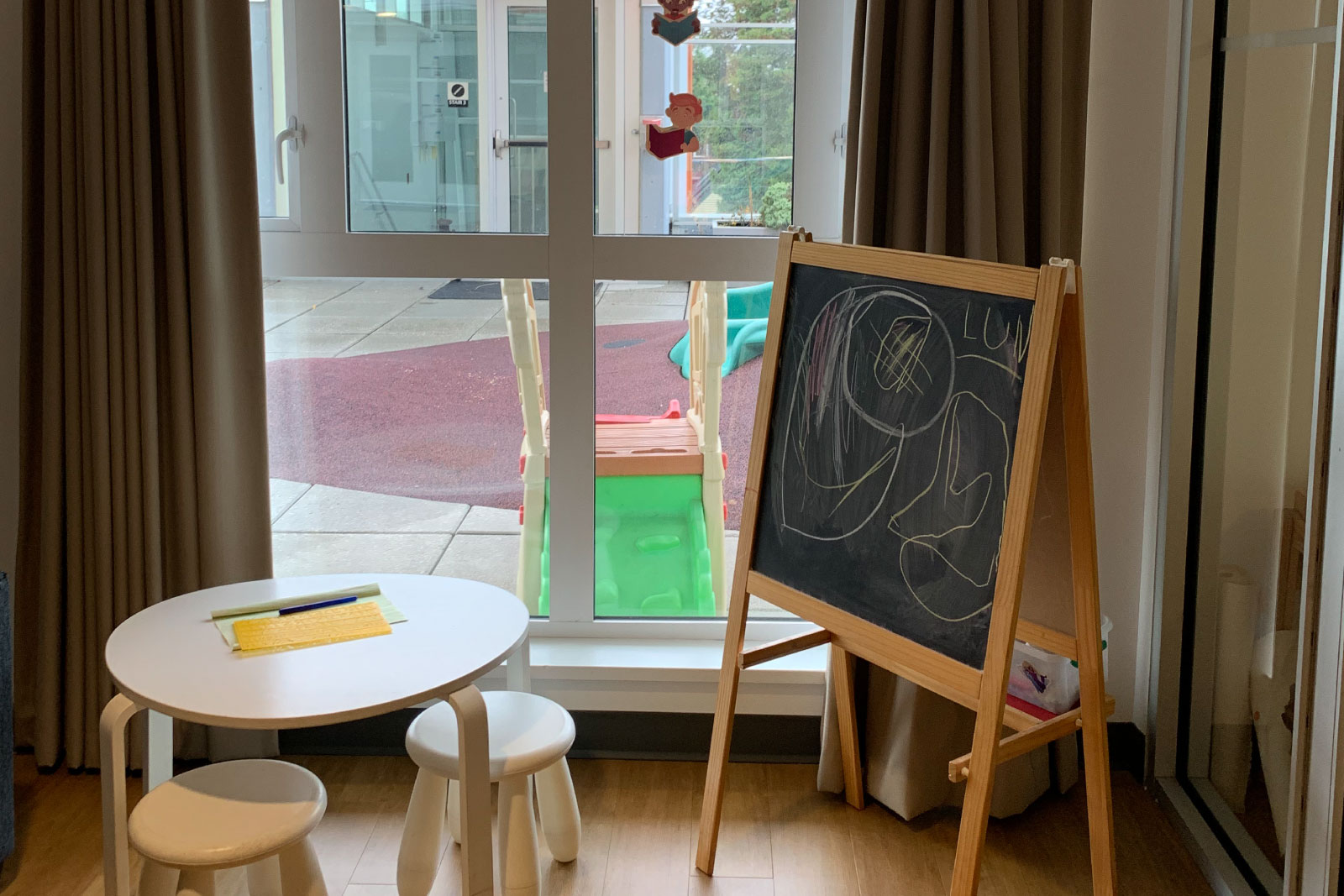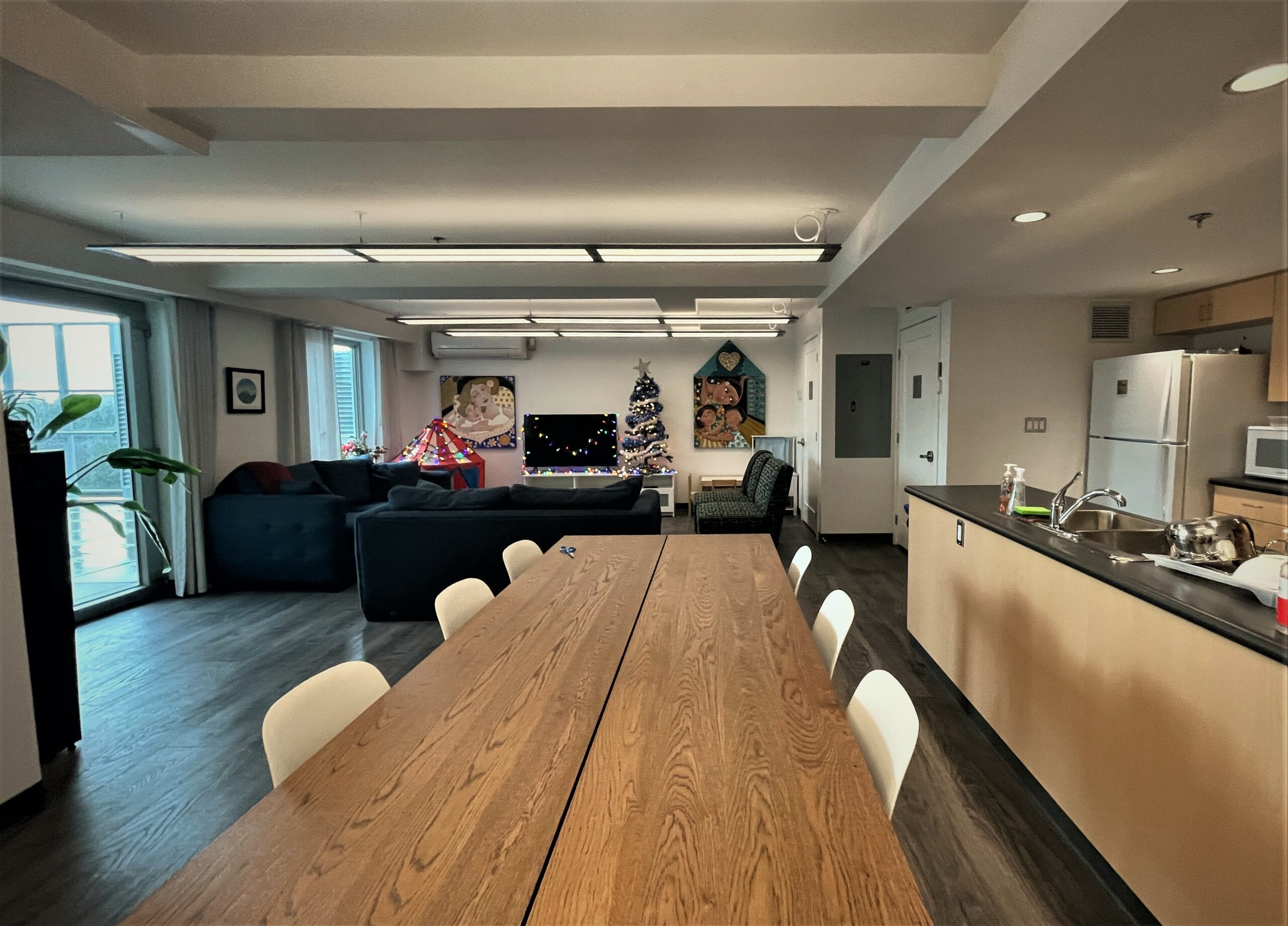Security & Sense of Safety | Convenience & Efficiency | Home-Like & Healing Environment | Physical Comfort | Community Support & Social Life
Community Support and Social Life
“I found when being surrounded with women who had gotten away, I felt more welcomed, there was an understanding, and so much more support. Without the empowerment from others, I wouldn’t have fought so hard. Socializing with survivors is such an important part of moving forward…maybe not for everyone but it was important to me.”
– Woman with Lived Experience
Although independent living is the goal of designing long-term housing for women and their children/dependents, access to on-site supports and services has been identified as beneficial. Also, having access to different semi-private semi-public spaces and amenities create opportunities to connect with others with similar experiences, and support children of different ages. Such gathering spaces and supports reduce the social isolation that women may experience after fleeing violence particularly as they may be also moving out of communal living of Transition and/or Second Stage housing programs with support services (Akbarnejad et al., 2022; CMHC, 2019a; Vaccaro & Craig, 2020; Zinni, 2019).
Having the option and choice to make connections with other members of their housing community was one factor that women identified as helping them to heal from past trauma. Women’s perceptions of safety are fostered in a building where connections can happen organically for women and their children and that allow for integration within the community. The balance between sense of safety and connections with others is a vital aspect of women-centred housing and in this regard, community size has been identified as an important consideration.

Figure 22: Shared amenity room in YWCA Cause We Care building

Figure 23: Shared communal space in YWCA Pacific Spirit Terrace building
Design Strategies
Diversity of On-Site Amenities (e.g., size, function, softness, furniture)
In order for shared spaces to be utilized to their full potential, they need to be inclusive of diverse ages, abilities, and other identity groups. Also, there should be amenity options that can be used in different weather conditions. The more shared spaces are utilized, the more opportunities for socializing.
Residents’ Involvement
Involvement of women and children in shaping the shared spaces of their buildings provides a sense of ownership over these spaces and facilitates opportunities for connections, collaboration, and exchanging resources and skills with other neighbours.
Safe Amenities
The safer the shared amenities are, the more women and their children/dependants will be interested and comfortable in using them. As a result, there will be more opportunities for connections with others.
Community Size
Research suggests there is an optimal community size that has the potential for enhanced sense of community and safety.
Space Layout
Where the different spaces in the unit and common areas are located and the ways they are arranged next to other spaces impacts the potential for socializing among the residents.
Access to Community Centers and Supports
Women stated that having support nearby in proximity of their housing provides them with the choice to reach out when they need to.
Strategy
Action
Diversity of On-Site Amenities (e.g., size, function, softness, furniture)
In order for shared spaces to be utilized to their full potential, they need to be inclusive of diverse ages, abilities, and other identity groups. Also, there should be amenity options that can be used in different weather conditions. The more shared spaces are utilized, the more opportunities for socializing.
- Common area: Large shared living room; playroom/game room to share after school care.
- Common area: Party room to enable affordable birthday parties.
- Common area: Volunteer space for sharing skills and empowering women.
- Common area: Shared kitchen/communal cooking; Lounge/amenity room with a full kitchen.
- Common area: Courtyard/rooftop garden.
- Common area: Spaces to support artwork, hot-desking, yoga, and other activities.
- Common area: On-site children’s play space with space for adults to mingle. A mix of both outdoor play space (including a shaded/covered area) and indoor play area enables their use in different weather conditions and seasons.
- Common area: Benches and picnic tables and a variety of seating options for different group sizes and activities.
- Communal area: Provide both built-in (fixed) furniture for dual uses (storage) and free standing seating options (Donnelly et al., 2022).
- Common area: Space for older children (pre-teens and teens) to be active (e.g., basketball, skateboarding in the complex).
Residents’ Involvement
Involvement of women and children in shaping the shared spaces of their buildings provides a sense of ownership over these spaces and facilitates opportunities for connections, collaboration, and exchanging resources and skills with other neighbours.
- Common area: Keep the shared amenities incomplete in order to let residents engage in shaping the space according to their needs and interests (e.g., choosing/making art).
- Common area: Shared library/tool library builds community. For example, provide built-in shelving in shared spaces to enable book sharing among neighbours.
- Common area: Chalkboard walls for messaging among residents.
- Common area: Community pantry and shared food space.
- Common area: Clearly defined community garden areas with access to tools, materials and water; Engaging women and children in choosing the plant types (Donnelly et al., 2022).
Safe Amenities
The safer the shared amenities are, the more women and their children/dependants will be interested and comfortable in using them. As a result, there will be more opportunities for connections with others.
- Please refer to “Security and Sense of Safety” Section to learn the strategies and actions for designing safe and secure spaces.
Community Size
Research suggests there is an optimal community size that has the potential for enhanced sense of community and safety.
- Unit: Community in block/buildings of more than approx. 30 units may become anonymous, and hinder social control (City of Vienna, 2013, p. 88).
- Units: Comparing 6-storey multiplexes to high-rise towers, a sense of community and safety is better achieved in a multiplex (City of Toronto, 2022).
- Common areas: In most multi-family housing settings, residents report feeling less crowding and greater connection with neighbours when semi-private common spaces are shared by no more than 12 adults and their children (Happy Cities, n.d.).
Space Layout
Where the different spaces in the unit and common areas are located and the ways they are arranged next to other spaces impacts the potential for socializing among the residents.
- Unit: Visual connections between the kitchen and living/dining area allows for socializing between family members while carrying out different tasks.
- Common area: Amenity space next to the shared laundry where people can hangout, watch children play for connections and usability at the same time.
- Common area: Amenity spaces that open into shared courtyard.
- Common area: Glass doors/windows to communal rooms so people can see who is in there and what is happening and can decide whether they want to join.
- Common area: Allocate space for on-site staff near shared amenity or next to the entrance.
- Common area: Communal space should be centrally located and accessible to all residents (Donnelly et al., 2022).
Access to Community Centers and Supports
Women stated that having support nearby in proximity of their housing provides them with the choice to reach out when they need to.
- Common area: Allocate space for on-site staff to promote a sense of community building and support when needed.
- Connection to neighbourhood: Locate housing close to cultural, spiritual and religious centers and supports (CMHC, 2019a; Vaccaro & Craig, 2020).
Other Resources: See Happy Homes Toolkit and the Hey Neighbour Collective’s work for more design and programming ideas to enhance social connectedness in multi-unit rental housing.

